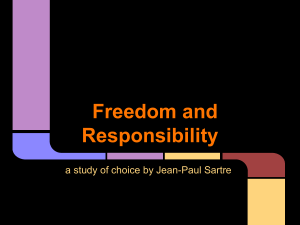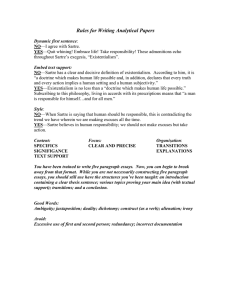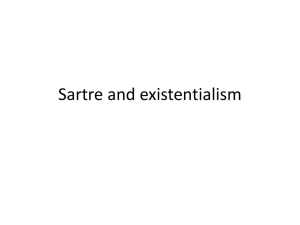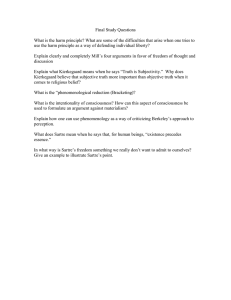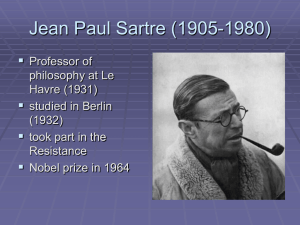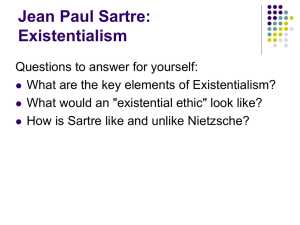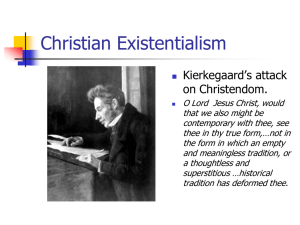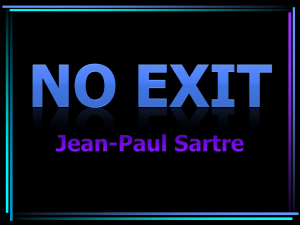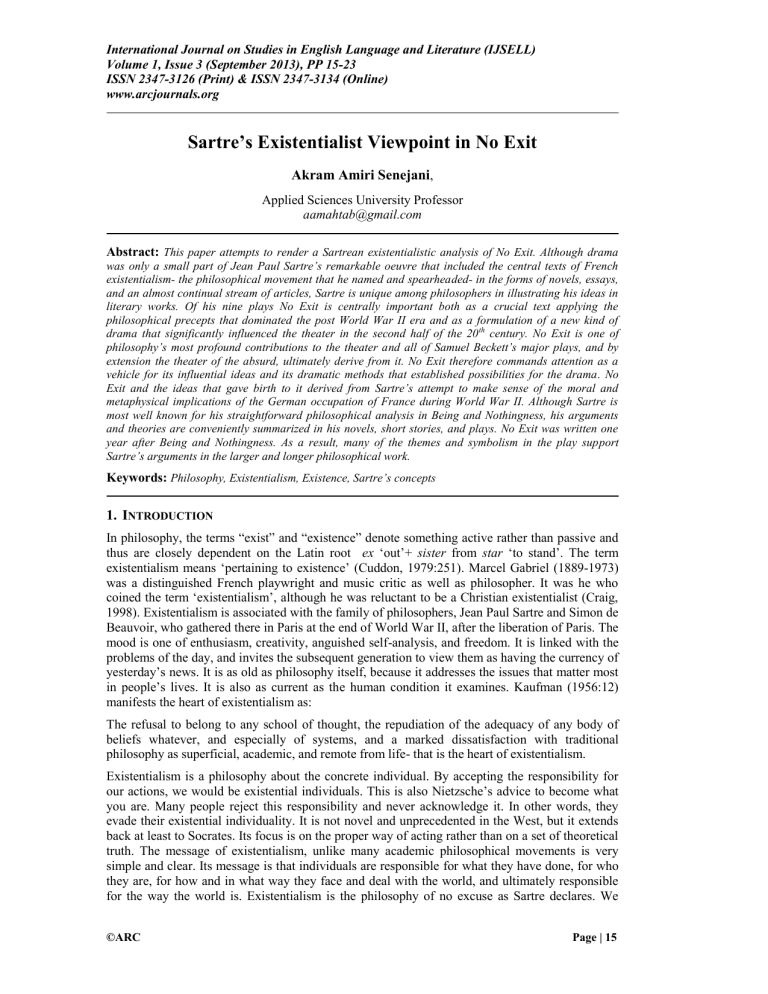
International Journal on Studies in English Language and Literature (IJSELL) Volume 1, Issue 3 (September 2013), PP 15-23 ISSN 2347-3126 (Print) & ISSN 2347-3134 (Online) www.arcjournals.org Sartre’s Existentialist Viewpoint in No Exit Akram Amiri Senejani, Applied Sciences University Professor aamahtab@gmail.com Abstract: This paper attempts to render a Sartrean existentialistic analysis of No Exit. Although drama was only a small part of Jean Paul Sartre’s remarkable oeuvre that included the central texts of French existentialism- the philosophical movement that he named and spearheaded- in the forms of novels, essays, and an almost continual stream of articles, Sartre is unique among philosophers in illustrating his ideas in literary works. Of his nine plays No Exit is centrally important both as a crucial text applying the philosophical precepts that dominated the post World War II era and as a formulation of a new kind of drama that significantly influenced the theater in the second half of the 20 th century. No Exit is one of philosophy’s most profound contributions to the theater and all of Samuel Beckett’s major plays, and by extension the theater of the absurd, ultimately derive from it. No Exit therefore commands attention as a vehicle for its influential ideas and its dramatic methods that established possibilities for the drama. No Exit and the ideas that gave birth to it derived from Sartre’s attempt to make sense of the moral and metaphysical implications of the German occupation of France during World War II. Although Sartre is most well known for his straightforward philosophical analysis in Being and Nothingness, his arguments and theories are conveniently summarized in his novels, short stories, and plays. No Exit was written one year after Being and Nothingness. As a result, many of the themes and symbolism in the play support Sartre’s arguments in the larger and longer philosophical work. Keywords: Philosophy, Existentialism, Existence, Sartre’s concepts 1. INTRODUCTION In philosophy, the terms “exist” and “existence” denote something active rather than passive and thus are closely dependent on the Latin root ex „out‟+ sister from star „to stand‟. The term existentialism means „pertaining to existence‟ (Cuddon, 1979:251). Marcel Gabriel (1889-1973) was a distinguished French playwright and music critic as well as philosopher. It was he who coined the term „existentialism‟, although he was reluctant to be a Christian existentialist (Craig, 1998). Existentialism is associated with the family of philosophers, Jean Paul Sartre and Simon de Beauvoir, who gathered there in Paris at the end of World War II, after the liberation of Paris. The mood is one of enthusiasm, creativity, anguished self-analysis, and freedom. It is linked with the problems of the day, and invites the subsequent generation to view them as having the currency of yesterday‟s news. It is as old as philosophy itself, because it addresses the issues that matter most in people‟s lives. It is also as current as the human condition it examines. Kaufman (1956:12) manifests the heart of existentialism as: The refusal to belong to any school of thought, the repudiation of the adequacy of any body of beliefs whatever, and especially of systems, and a marked dissatisfaction with traditional philosophy as superficial, academic, and remote from life- that is the heart of existentialism. Existentialism is a philosophy about the concrete individual. By accepting the responsibility for our actions, we would be existential individuals. This is also Nietzsche‟s advice to become what you are. Many people reject this responsibility and never acknowledge it. In other words, they evade their existential individuality. It is not novel and unprecedented in the West, but it extends back at least to Socrates. Its focus is on the proper way of acting rather than on a set of theoretical truth. The message of existentialism, unlike many academic philosophical movements is very simple and clear. Its message is that individuals are responsible for what they have done, for who they are, for how and in what way they face and deal with the world, and ultimately responsible for the way the world is. Existentialism is the philosophy of no excuse as Sartre declares. We ©ARC Page | 15 Akram Amiri Senejani cannot shift our burden to God, or nature. If God exists, we choose to believe, if nature shows us the way of life, it is up to us to show what we do. The notion in existentialism is that, man spends his life changing his essence. There is not any objective form of truth, but the truth is formed by personal choice. Existentialism does not support the following concepts: first, wealth and honor make a good life; secondly, social values control an individual. Thirdly, acceptance of what happens to us, and never try to change it. Fourthly, science makes life better. What is important in existentialism is that, human being is free and his nature is made through his choice. According to Sartre (Flynn, 2006:12) “the fundamental choice man makes and gives direction to his life, is made by reflecting his previous life up to present. In other words we‟ve already made our choice implicitly”. The best individual is the one who struggles for his life. Decisions made by individual are not without consequences. While many philosophers criticize our feeling and emotions, existentialists put great significance on such emotions as anguish, anxiety and dread. Soren Kierkegaard has an unconditional commitment, an infinite passion for something finite. For Kierkegaard, the infinite passion can be legitimately called infinite because it opens up a world. Not only what actually exists gets its meaning from its connection with the defining passion, but also anything that could possibly come into experience would get its meaning from one‟s defining commitment. This emphasis on emotions links them to artists who care for our emotional and imaginative lives. This relation between existentialism and fine arts, makes existentialism a solely movement for some critics. Existential ideas come to focus after a deep sense of despair following World War II and the Great Depression. Kierkegaard, Jasper, and Marcel are religious philosophers or theists, while Sartre, Camus, De Beauvoir and Heidegger are atheists, and Nietzsche an antichristian. All believe that human life is not complete, and satisfying. Every individual experiences suffering and loss, due mainly to his lack of power and control over his life. However they believe that although life is not satisfying, it has meaning. Existentialism is the root of Absurdism. Like existentialism that deals with human life or existence, his condition, freedom, responsibility, as well as passions like anxiety and dread, Absurdism is the offspring of existentialism. It designates the meaninglessness of man‟s life. Absurd, as Esslin (1968:23) comments means “out of harmony in a musical context”. In common usage absurd means ridiculous. Ionesco (Esslin, 1968:23) in an essay on Kafka defines absurd as “devoid of purpose…cut off from his religious, metaphysical, and transcendental roots, man is lost. All his actions become senseless, absurd, and useless”. The sense of anguish or anxiety about the meaninglessness, and absurdity of human condition as Esslin (1968:24) declares is: Broadly speaking the theme of the plays of Becket, Adamove, Ionesco, Genet and other writers like Pinter and Albee is about absurdism, like existentialism it depicts the inadequacy of rational approach by the open abandonment of rational devices and discursive thought.Although the theories advanced by different existentialist writers diverge widely in many important respects, so that it would be misleading to speak of a philosophical school or movement, certain underlying concepts can be singled out as the characteristics of existentialism. There are five basic concepts that the existentialist appropriates each in his or her own way. Rather than constituting a strict definition of existentialist, they depict more of a family resemblance among these philosophers: 1. Existence precedes essence: what you are (your essence) is the result of your choices (your existence) rather than the reverse. 2. Time is of the essence: We are fundamentally time-bound beings. Unlike measurable, clock time, lived time is qualitative: the „not yet‟, and the „present‟ differ among themselves in meaning and value. 3. Humanism:Existentialism is a person-centered philosophy. 4. Freedom/responsibility: in existentialism existence precedes essence, so man has no predetermined nature. 5. Ethical considerations are paramount: though each existentialist understands the ethical, as with freedom, in his or her own way, the underlying concern is to invite us to examine the authenticity of our personal lives and of our society. International Journal on Studies in English Language and Literature (IJSELL) Page | 16 Sartre’s Existentialist Viewpoint In No Exit Western philosophical tradition is based on the classical assumption that essence precedes existence. This view diverts our attention from this imperfect world. Sartre (Wicks,2006:212) concerning the otherworldliness inherent in this view maintains: What do we mean by saying that existence precedes essence? We mean that man first of all exists, encounters himself, surges up in the world and defines himself afterwards. If man as the existentialist sees him is not definable, it is because to begin with he is nothing. He will not be anything until later, and then he will be what he makes of himself. Thus there is no human nature…Man simply is…Man is nothing else but that which he makes of himself. That is the first principle of existentialism. On 29 October, 1945 Jean Paul Sartre delivered a lecture entitled Is Existentialism a Humanism? His lecture defines the crucial tenets of Sartrean existentialism, the claim that existence precedes essence. Based on this lecture our freedom is the ultimate value of our existence that we seek earnestly, and that each individual is alone to create his own values and universe that is devoid of any moral order to guide individuals. For him, when there is no God there is no human nature. Our anxiety is our awareness that we are alone to choose our destiny. By asserting that existentialism is humanism, Sartre (Flynn, 2006:47) declares, “it places the human being at the center of its attention and the apex of its value hierarchy”. He believes that individual‟s freedom is of utmost importance. Sartre (Flynn,2006:47) insists: The ultimate value, the goal of our endeavors, should be the fostering of the freedom of the individual, by which he means the enhancement of his or her concrete possibilities of choices. The creative freedom, he implies, should not be sacrificed to any higher value, whether it be the class of the Marxists or the God of the religious believers. 2. DISCUSSION Born in Paris in 1905, Sartre was the only son of a naval officer who died when Sartre was only 15 months old. His mother, a second cousin of the German-born theologian, musicologist, humanitarian, and Nobel laureate Albert Schweitzer, raised her son with the help of her grandparents. One of Sartre‟s earliest intellectual influences was his grandfather Charles Schweitzer, a professor of German, who educated his grandson and stimulated Sartre‟s love of literature and intellectual ambition. The central trauma of Sartre‟s childhood came when his mother remarried in 1916 to a man Sartre despised. Sartre would feel both abandoned and dispossessed in his home, feelings that would later figure prominently as the existential anguish of a purposeless life. Sartre attended the Ecole Normale Superieure where he studied philosophy and met fellow philosophy student Simone de Beauvoir, with whom he would maintain a lifelong personal and intellectual relationship. Sartre spent much of the 1930s teaching philosophy and studying the works of German philosophers Edmund Husserl and Martin Hidegger, who along with Friedrich Nietzsche and Soren Kierkegaard, anticipated many of the key concepts of existentialism. Sartre‟s prewar philosophical writings reflect the influence of Husserl‟s phenomenology and focus on the workings and structure of consciousness. Sartre‟s first novel, LA Nausee depicts a man‟s reaction to the absurdity of existence, and his story collection Le Mur offers various explorations of relationships, sexuality, insanity, and the implication of human action-scenarios that prefigure an analysis of the human condition Sartre would evolve in existentialism. With the outbreak of the war Sartre joined the army, was captured by the Germans, and spent nine months in a prison camp. There he began his career as a playwright, writing, directing, and acting in a Christmas play for his fellow prisoners of war, Bariona or The Son of Thunder. Responding to the sense of helplessness and despair felt by the French under the German occupation, existentialism recognizes that even in the worst circumstances humans still have choices and therefore freedom. Human consciousness Sartre argues requires meaning through choices and all are responsible to consider the ramifications of choices made or not made and fully accept the consequences. Evasion results in inauthentic action, delusion, or what Sartre calls “bad faith”. An encouragement toward action and responsibility under an oppressive regime that negated both, existentialism as articulated by Sartre and fellow writer Albert Camus, whom Sartre first met at a performance of The Flies, would serve as a compelling response to the horrors of the war that diminished free will and responsibility. International Journal on Studies in English Language and Literature (IJSELL) Page | 17 Akram Amiri Senejani Sartre‟s next play , No Exit, is a forceful parable embodying the key concepts of existentialism. In it Sartre made a virtue of the conditions governing French theater under the occupation. Censorship restricted what could be said on stage, and practical considerations, including the curfew and limited resources, constrained how. The actress Gaby Sylvia, who played the role of Estelle in No Exit‟s first performance, recalled that the play originated when Camus asked Sartre for a short play for four characters that could be performed in the home of friends: What do you find in any living room? A sofa, a small table, armchairs, a mantel piece and sometimes a Barbedienne bronze sculpture. So much for the set. There would be no intermission, because of the curfew. Next necessity. There had to be a reason that these four characters are together in a living room and unable to leave it. “Let‟s shove them into hell” Sartre said to himself. And in two weeks at a table at the [Café] Flore he wrote No Exit. Sartre‟s own account, recollected many years after the fact, differs slightly:When one writes a play, there are always chance circumstances and deep needs. The chance circumstance when I wrote No Exit in 1943 or the beginning of 1944 was the fact that I had three friends for whom I wanted to write a play, without giving any one of them a larger part than the others. In other words, I wanted them to be together on the stage all the time, because I said to myself: “If one of them leave the stage, he‟ll think that the other two have better parts in his absence‟. So I wanted to keep them together, and I said to myself: “How can one put three characters together without an exit, and keep them there on stage to the end of the play, as though eternally?” That‟s when the idea came to me to put them in hell and make each one of them the torturer of the other two. That‟s the circumstantial cause.Initially called “Les Autres” (The Others), about characters trapped in a cellar during a bombardment Sartre shifted the setting to hell, which resembled the Paris hotel room where the play was first rehearsed. Sartre would describe this new French drama in a 1946 lecture he delivered in the United States, “Forgers of Myths”, in which he called for the replacing of the 19th-century psychological theater of “caracteres” (personalities) by “ un theater de situations” : Since the situation is what we care about above all, our theater shows it at the very point where it is about to reach its climax. We do not take time out for learned research, we feel no need of registering the imperceptible evolution of a character or a plot: one does not reach death by degrees, one is suddenly confronted with it- and if one approaches politics or love by slow degrees, then acute problems, arising suddenly, call for no progression. By taking our dramatis personae and precipitating them, in the very first scene, into the highest pitch of their conflicts we turn to the well-known pattern of classical tragedy, which always seizes upon the action at the very moment it is headed for catastrophe. 3. IN WHAT CAN SERVE BOTH AS AN ENCAPSULATING DESCRIPTION OF NO EXIT MANY OF THE PLAYS THAT WOULD FOLLOW IT, SARTRE SUMMARIZES AND Our plays are violent and brief, centered around one single event; there are few players and the story is compressed within a short space of time, sometimes only a few hours. As a result they obey a kind of “rule of the three unities”, which has been only a little rejuvenated and modified. A single set, a few entrances, a few exits, intense arguments among the characters who defend their individual rights with passions- this is what sets our plays at a great distance from the brilliant fantasies of Broadway. No Exit is a one-act play for four actors (one of whom, the Valet, appears only a very limited time) and only one scene. The play begins with a Valet leading a man named Joseph Garcin into a room that the audience soon realizes is in hell (hell is described as a series of rooms and passages). The room has no windows, no mirrors, and only one door. Eve3ntually Garcin is joined by Ines Serrano, and then another woman, Estelle Rigault. After their entry, the Valet leaves and the door is closed and locked. All expect to be tortured, but no torturer arrives. Instead, they are left to probe each other‟s sins, desires and unpleasant memories, gradually realizing that this is their punishment; they are each other‟s torturers. At first, the three see events concerning themselves that are happening on Earth, but eventually they are left with only their own thoughts and the company of the other two. Near the end of the play, Garcin demands he be let out; at his words the door flies open, however, none of the three International Journal on Studies in English Language and Literature (IJSELL) Page | 18 Sartre’s Existentialist Viewpoint In No Exit will leave. This is due partly to the substantial hate and fear of the unknown, but primarily to Garcin‟s desire for validation from Ines that he is not a coward. Garcin‟s sins are cowardice and callousness. He deserted the army during World War II, and he blatantly cheated on his wife- he even brings his affairs home and gets her to make them coffee in bed, without any sympathy. Initially, he hates Ines because she understands his weakness, and lusts after Eestelle because he feels that if she treats him as a man he will become manly. However, by the end of the play he understands that because Ines understands the meaning of cowardice and wickedness, only absolution at her hands can redeem him.Ines is the second character to enter the room. A lesbian postal clerk, her sin is turning a wife against her husband, twisting the wife‟s perception of her spouse and the subsequent murder of the man (who is Ines‟ cousin). Indeed Ines seems to be the only character who understands the power of opinion, manipulating Estelle‟s and Garcin‟s opinions of themselves and of each other throughout the play. She is the only character who is honest about the evil deeds she, Garcin and Estelle have done. She commonly acknowledges the fact that she is a cruel person. Estelle is a high society woman, a blonde who married her husband for his money and had an affair with a younger man. To her, the affair is merely an insignificant fling, whereas her lover becomes emotionally attached to her and she bears an illegitimate child. She drowns the illegitimate child by throwing it into the lake, which drives her lover to commit suicide. Throughout the play she makes advances toward Garcin, seeking to define herself as a woman in relation to a man. Her sins are deceit and murder. She lusts over “manly men”, which Garcin himself strives to be. The Valet enters the room with each character, but his only real dialogue is with Garcin. We learn little about him, except that his uncle is the head valet. And that he does not have any eyelids, which links to Garcin because his eyelids are atrophied. No Exit takes an interesting setting, that of the afterlife. Hell, as portrayed in this work, is no more than a room with three couches and Second Empire decorum. There are no mirrors, no windows, no books, generally no form of amusement. Some very human privileges that we take for granted have also been taken away: sleep, tears, and even momentary reprieves of blinking. Each of the three characters is introduced into the room by a surprisingly polite Valet. Initial confrontations are “uncomfortable”, each person knowing that he/she is deceased, but they are not impolite. However, as the true reasons why each person has been sentenced to Hell are revealed, the true nature of the place takes shape. The first person to appear in the play is Mr. Garcin. At first glance, he is a very polite, gentlemanly, and moral individual. However, the further into the play that we read, we find that he is none of these things. Instead he represents some of the worst ails that afflict humankind (according to Sartre). He was graced with a wife that loved him unconditionally, and he loathed for no other reason. In fact, one the first memories that he has of her is how “she got on his nerves”. There is one story that is obviously intended to shock the reader, and provide a good interpretation of Garcin‟s true character. He states: “Well here‟s something you can get your teeth into. I brought a half-caste girl to stay in our house. My wife slept upstairs; she must have heard- everything. She was an early riser, and as I and the girl stayed in bed late, she served us our morning coffee”. (No Exit, p. 25) This fact is the one that he believes condemned him to his fate in Hell. Chronologically, this is our first example of sexual perversion. Garcin was a complete womanizer; he dominated his wife in any way possible, and used other women for nothing other than sex. Sartre would say that he destroyed any gains from sexual desire by actually fulfilling those needs. The play serves to enforce that idea. Not only does Garcin know that it was this behavior that brought him to Hell, but he sees his wife in a saintly light. His words insinuate that Garcin did not have a sexual relationship with his wife, and yet she still craved him. This is meant to enforce the desire theory. Garcin hated his wife for wanting him so much, she had achieved the ultimate end of sexuality, a state that he spent his time continually destroying. Therefore, it was not so much hatred, but it‟s remarkably similar cousin: jealousy. However, what proves even more interesting is the case of his desertion from the military. He was formerly a “pacifist reporter”. This supposed pacifism was the cause of his death. A time of war International Journal on Studies in English Language and Literature (IJSELL) Page | 19 Akram Amiri Senejani eventually erupted around him, and he was demanded to fight. It was his desertion for which he was summarily killed by firing squad. Yet, that brief story is not quite correct. Anyone who chose pacifism would certainly not be punished. This is presented as Sartre‟s classic case of bad faith. Further into the story, as Garcin watches his colleagues on Earth, discovers they are viewing him as a coward. He is quickly engulfed in rage, disgusted that his peers could brand him a coward supposedly knowing his character. All of this is understandable, except that Garcin himself questions his true motives in running from service. One of his roommates, Ines asks of him: “That‟s the question. Was that your real motive? No doubt you argued it out with yourself, you weighed the pros and cons, and you found good reasons for what you did. But fear and hatred and all the dirty little instincts one keeps dark- they‟re motives too. So carry on, Mr. Garcin, and try to be honest with yourself- for once”. (No Exit, p. 38-39) It could not be imagined a better description of bad faith short of Sartre‟s original work. Garcin had convinced himself that he was truly a great man, showing his disgust with violence by choosing not to participate in the war, or, was he truly just hiding the true motive for his desertion; fear? Sartre presents to us the situation of the waiter, one who is a waiter by trade but chooses to believe that “he is not truly a waiter”. He acts as a waiter, is he not a waiter? The same logic applies to our subject Mr. Garcin. By his actions he is a coward, running from service while questioning his own motivation to do so. At a later stage in the play, Garcin manages to open the door to the corridor in an attempt to leave. Yet, he cannot leave. The very fact that Ines has identified that bad faith makes him stay. Estelle, grappling for his attention, tries to push Ines into the hallway and close the door. But Garcin will not allow it. Garcin: It is because of her [Ines] that I‟m staying. yes, you [Ines] anyhow, know what it means to be a coward. And you know what it means to be a coward. And you know what wickedness is, and shame, and fear. There were days when you peered into yourself, into the secret places of your heart, and what you saw there made you faint with horror. And then, next day, you didn‟t know what to make of it, you couldn‟t interpret the horror you had glimpsed the day before. Yes you know what evil costs. And when you say I‟m a coward, you know from experience what that means. (No Exit, p.43) At the same time Sartre is briefly introducing the idea of “pools of nothingness”. Garcin stands at the door, ready to leave his two cellmates forever. But he cannot leave. Ines‟ lack of respect for him, her poor interpretation of his character leaves too bad a taste in his mouth. There is a pool of nothingness where he needs her respect. Leaving the room represents the impossibility of filling that void. As the door pops open from Garcin‟s efforts, the three remain motionless: Ines; So what? Which shall it be? Which of the three of us will leave? The barrier‟s down, why are we waiting? But what a situation! It‟s a scream! We are inseparables! (No Exit, p.43) While Garcin questions his character or lack thereof, the lovely character of Estelle is a wonderful example of objectivity. Without fail, she spends more time worrying about her make-up and appearance than the true nature or reason for her insertion into Hell. In fact, her only true need is that she be needed or ogled by a man. None of her supposed values are that at all. As her story goes, she lost her parents young, raised her brother, and married a rich man whom she did not love. Eventually, she took on a lover, Roger, who wanted her to have a child. As stated in the play: Garcin: And you didn‟t want one [ a baby]? Estelle: I certainly didn‟t. But the baby came, worse luck. I went to Switzerland for five months. No one knew anything. It was a girl. Roger was with me when she was born. It pleased him to no end, having a daughter. It didn‟t please me! There was a balcony overlooking the lake. I brought a big stone. He could see what I was up to and he kept on shouting: “Estelle, for God‟s sake, don‟t” I hated him then. He saw it all. He was leaning over the balcony and he saw the rings spreading on the water” Following this sequence, her lover returns to Paris and quickly commits suicide. Her retort to this is questioning, she cannot understand why he would do this when her husband didn‟t suspect a thing. International Journal on Studies in English Language and Literature (IJSELL) Page | 20 Sartre’s Existentialist Viewpoint In No Exit Upon materializing their love with a child, Estelle had no more use for Roger. While we would think that such an event would infuse love and passion into a relationship, she loathed the fact that he was so infatuated with her. It is viewed an interpretation of not only Sartre‟s views on blind objectivity and social stature, but also of sexual perversion. Estelle needs someone to desire her, she has an insatiable appetite for being coveted. One might think that this could be satisfied by the everyday attention a child might get. However, Sartre is very careful to build a situation where sexual desire and reciprocity is the only possible solution to the problem. Estelle is continually confronted by Ines, who has already expressed her desire. These advances are rejected outright. Estelle continually pecks at Garcin, asking for some spark of interest. Her actions have given us more evidence to Sartre‟s theory of sexual desire and its relation to sexual perversion. The most prolific and impressive state of any sexual interaction is that of desire. Unfortunately it is a state that is inherently unstable. The only way to satisfy the sexual desire one feels is through the physical act. As we see from Estelle‟s story (and her opinion of it), this quickly degrades. The characters, and Sartre, believe that the state of sexual desire is so alluring that it is irresistible. Estelle has no shame about expressing this theme, constantly demanding that Garcin shows some physical affection. It was this affection, and its ends that originally sentenced her to Hell! In addition to this story, Estelle goes on to enhance the sexual perversion theme when discussing Peter, a boy she knew in life. She can see him dancing with her best friend Ogla, and is very quickly angered: Ines; Do you love him? Estelle: …No, of course I don‟t love him; he‟s only eighteen, and I‟m not a baby- snatcher. Ines: Then why bother about them? What difference can it make? Estelle: He belonged to me. The third character is Ines Serrano. She is presented as an incarnation of what we would all consider to be evil. She and Garcin are the first two individuals to enter the room, and she instantly believes that he is the torturer. Garcin is shocked and amazed, and after explaining that he is no such person asks why she would t5hink so. Garcin: Frightened! But how ridiculous! Of whom should they [the torturers] be frightened? Of their victims? Ines: Laugh away, but I know what I‟m talking about. I‟ve often watched my face in the glassThis is the first indication of what Ines is truly like. She is very willing to admit her nature, that of a sadistic torturing soul. Her end comes at the hands f her lover Florence, a girl she had stolen away from her cousin. The only pleasure that Florence truly brought Ines was through her manipulation. In Ines‟ words: Ines:…I crept inside her skin, she saw the world through my eyes. When she left him, I had her on my hands. Later, she gives an explanation for her actions: Ines: When I say I‟m cruel, I mean I can‟t get on without making people suffer. Like a live coal. A live coal in another one‟s heart. When I‟m alone I flicker out. For six months I flamed away in her heart, till there was nothing but a cinder. One night she got up and turned on the gas while I was asleep. Then she crept back into bed. So now you know.Ines is common evil. She serves to torture Garcin with her non- belief in his character, and to provide a reali8stic light to the entire group. While the others are trying to elude themselves with arguments of randomness or nonsense, Ines refuses to fall victim. She knows why things have been laid out as they have, why these three people have been chosen to exist in eternity together. Most importantly, though Ines represents another even stronger, interpretation of Sartre‟s sexual perversion. Ines‟ vice is her need to fulfill her desire through the objectification and manipulation of her significant other. She describes her worldly lover Florence as a “tiresome little fool” and “I won‟t miss her in the least”. She has shown through self-description and opinion that this is not a clever ruse designed to fool her cohorts, it therefore shows that she has no warm feelings for International Journal on Studies in English Language and Literature (IJSELL) Page | 21 Akram Amiri Senejani Florence. She kept her around as a toy. In saying “she saw the world through my eyes”, it certainly sounds like she is trying to remove Florence‟s individuality. Florence should be deprived of even her own opinion because it I indicative of her personality. Achieving that level is the ultimate end of Sartre‟s sexual perversion. One wants another not as a complement one‟s consciousness, but rather as an object. Ines cannot escape these desires, even in the afterlife. This time, Estelle is the object of her affection. Garcin represents a threat to that end, Estelle seeks physical pleasure from him. Ines cannot imagine a fate worse than allowing Estelle to get away. As she said, she wants to crawl underneath her skin, to make Estelle see the world through her eyes. Is there a better definition of objectification of persons? It is as though Ines is trying to push the soul out of Estelle. Once she has been obtained, she is nothing more than a shell of a person, mental jewelry. The difference in this situation from the other two is that Ines knows why she desires another person. Most people are confused, and cannot see that the end of sexual desire is the act. Ines sees this, but as she says, uses it to torture other people. Slowly she pulls their individuality out, and replaces it with herself. While each person represents some existentialist theories, the setting and premise of the play represents one of the most important ideas Sartre has. That is, the world does not possess any meaning or characteristics; those are given to it by other consciousness. The source sink model is the best example of this theory. Each consciousness feeds off the world, giving it meaning and interpretation. One consciousness can feel it when another is infringing on that world. As stated by Ines: Ines: [We must try] To forget about the others? How utterly absurd! I feel you there, in every pore. Your silence clamors in my ears. You can nail your mouth shut, cut your tongue out- but you can‟t prevent your being there. Can you stop your thoughts? I hear them ticking away like a clock, tick-tock, tick-tock, and I‟m certain you hear mine… Some tortures seem specifically designed for satisfying this purpose. For instance, who would think that having no eyelids, no ability to blink would be a terrible torture? What is so bad about a small drawing room? Applying Sartre‟s theories, these punishments are the most foul available. For instance, the small drawing room is specifically designed to limit the universe. There are no windows, no mirrors, and no devices of attention (books, magazines, paintings). The entire universe, as it appears to these people, is this tiny room. In other words, the output of the source has been limited. Now, three people or three sinks are added to the universe. There is nothing that can attract their attention, they cannot engross themselves in a book, or spend time interpreting a painting. This removes the possibility that anyone “closes in on themselves” the way Sartre describes the man reading in the park: There, for example is a man who is reading while he walks. The disintegration of the universe which he represents is purely virtual: he has ears which do not hear, eyes which see nothing except his book. Between his book and him I apprehend an undeniable relation without distance of the same type as that which earlier connected the walker with the grass. But this time the form has closed in on itself. There is a full object for me to grasp. In the midst of the world I can say “man reading” as I could say “cold stone”, “fine rain”. (Oaklander, p.284).Even more horrifying, Hell has stolen away their ability to close their eyes. There is no way to turn off the sinks! Sartre takes less than fifty pages to materialize his existentialist ideas for the stage. He has given interpretations of sexual desire, bad faith, and conscious interactions. Sartre seeks to synthesize many of his philosophical arguments with fiction. Yet in a play about self-deception and bad faith the implicit double entendre of characters “play-acting” to be something they are not and actors pretending to play those characters, perfectly complements Sartre‟s straightforward philosophical argument. In effect, No Exit is a play about the devouring gaze of the other and how it restricts one‟s freedom, incorporated into the play itself and played out on stage through the gaze of each other, while their failure is played out by the constant state of the play‟s spectators. The play‟s central themes of freedom and responsibility come from Sartre‟s doctrine that “existence precedes essence”. Sartre believed that human consciousness, or being-for-itself, differs from inanimate objects, or a being-in-itself, since humans have the ability to choose and define their individual characteristics, or essence. But with this freedom of choice comes the absolute responsibility for one‟s action. The fear and anxiety of this responsibility leads many International Journal on Studies in English Language and Literature (IJSELL) Page | 22 Sartre’s Existentialist Viewpoint In No Exit people to ignore both their freedom and their responsibility by letting other people make their choices for them, resulting in bad faith. This is why Garcin is unable to leave the room when the door opens. He can‟t handle the responsibility of confronting his decision to flee his country, and thus leaves it up to Ines to judge him and define his essence. Similarly, Estelle does not think that she exists unless she looks in a mirror, seeing herself as others do. When Ines pretends to be her mirror and says Estelle has a pimple on her face, Estelle‟s bad faith causes her to accept someone else literally creating her essence. Both Estelle and Garcin are not only “condemned to be free”, but are willing to condemned themselves in order to avoid being free. This emphasis on bad faith establishes Sartre‟s underlying argument of the play: “Hell is other people”. Using only three people and an empty room, Sartre evokes scenes of utter torture and despair. In effect, Ines can‟t stand Garcin looking at her because she thinks that he is automatically judging her. Since she thinks that is her own role, she accuses him of stealing her face. Garcin mere existence thus reduces Ines‟ feelings of autonomy. Moreover, both Garcin and Estelle refuse to let go of their pasts, each looking at their friends and loved ones back on earth. They attempt to justify their existence by only thinking about their past experiences: as Garcin explains, his fate is the evaluation of his past actions by other people. Ines however, sees her past as meaningless and inaccessible, choosing to exist in the present instead. She insists to the others that nothing is left of them on earth and that “all you own is here”. Rather than justify her existence in terms of the person she used to be, Ines asserts her freedom to choose her essence in the present, even though she in hell. She is the only character in the play intend on confronting both her responsibility and her suffering an essential step is asserting her existence. As Sartre explains, “life begins on the other side of despair”. When validation and identity derives from others, others become hell, a state where torture is not meted out by devils but self-inflicted and inescapable. As Sartre observes, “Relations with other people, encrustration, and freedom…are the three themes of the play. I should like you to remember this when you hear that hell is other people”. (The Drama 100, p. 411) No Exit, as an intense and compressed dramatic parable, presents the core existential truth that each individual must ultimately face self truth and consequence, forced to an inescapable encounter with others who provide the measure for moral judgment. In the enclosed space of the stage that mirrors the enclosed self Sartre presents a modern morality play, while forecasting the themes and methods that emerge from the implications of an absurd universe and a search for new meaning. REFERENCES Craig,Edward.Routledge Ensyclopedia of Philosophy.10 vols.1998. Cuddon,J.A. A Dictionary of Literary Terms. New York:Penguin Books Ltd.,1979. Cummings, Robert D. The Philosophy of Jean-Paul Sartre. Trans/ed. Sartre, Jean-Paul. Vintage Books USA, Aug 1972. Esslin, Martin.The Theatre of The Absurd.London:Eyre and Spotiswood,1968. Flynn,Thomas.Existentialism A Very Short Introdction.New York:Oxford University Press,2006. Kaufmann, Walter.Existentialism from Dostoevsky to Sartre.New York:Meridian Books,1956. Minahen, Charles D. Situating Sartre in Twentieth-Century Thought and Culture. Trans/ed. Fourney, Jean-Francois. St. Martin's Press, Sep 1997. Sartre, Jean-Paul. No Exit, and Three Other Plays. Vintage Books USA, Nov 1989. Sartre, Jean-Paul. The Philosophy of Jean-Paul Sartre. Trans/ed. Schilpp, Paul Arthur. Open Court Publishing Company, Mar 1991. Sarte, Jean-Paul. Search for a Method. Trans/ed. Barnes, Hazel E. Vintage Books USA, Aug 1968. Sartre, Jean-Paul. Truth and Existence. Trans/ed. Van Den Hoven, Adrian and Ronald Aronson. University of Chicago Press, Apr 1995. Sartre, Jean-Paul. Literature & Existentialism(New York: Citadel Press, 1962) Wicks, Robert.”French Existentialism”. A Companion to Phenomenology and Existentialism. Eds. Hubert L. Dreyfus.Oxford:Blackwell,2006. International Journal on Studies in English Language and Literature (IJSELL) Page | 23
